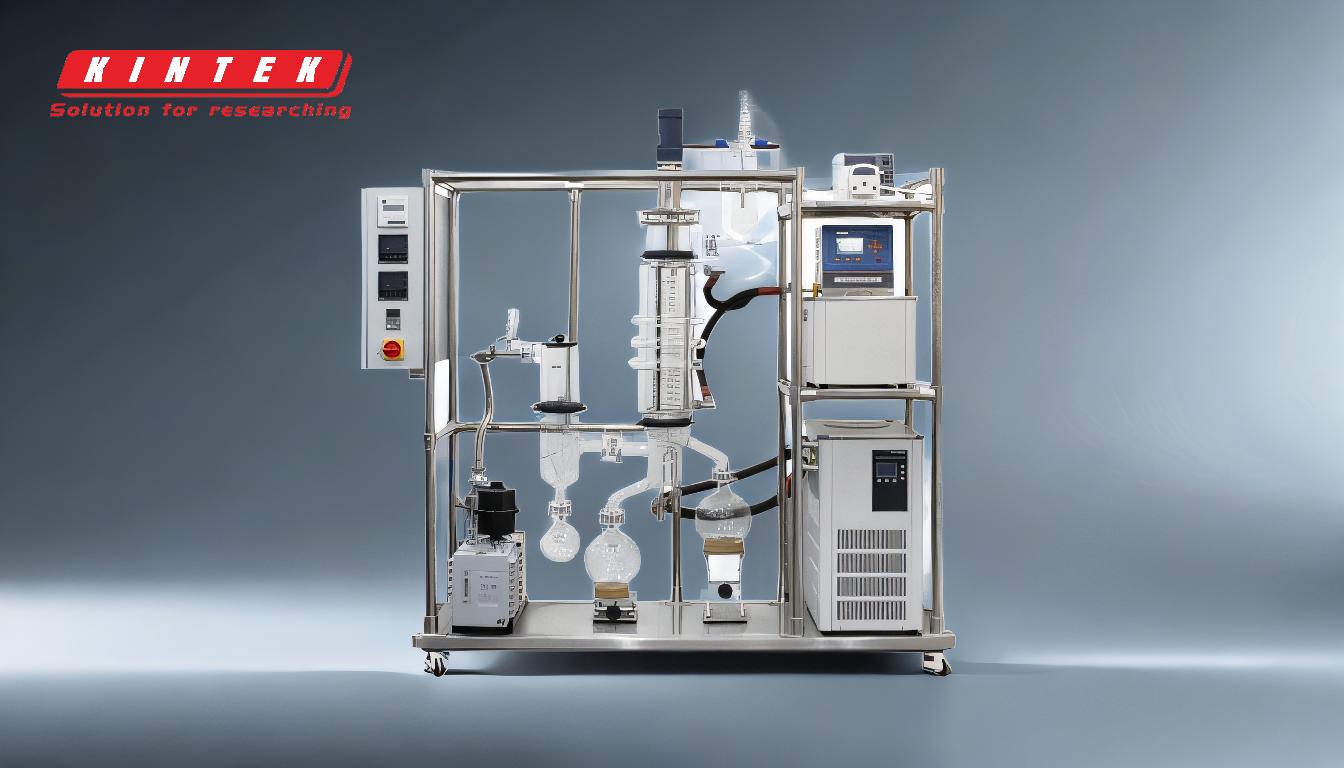Wiped film distillation (WFD) is a specialized distillation technique used to separate and purify heat-sensitive materials, such as oils, essential oils, and cannabinoids, under reduced pressure and controlled temperatures. The process involves creating a thin, turbulent film of the feedstock on a heated surface using rotating wipers or rollers. This thin film enhances heat transfer and evaporation efficiency, allowing volatile components to vaporize while heavier residues are collected separately. The vaporized components are then condensed and collected as distillate, while the process minimizes thermal degradation by reducing exposure time to heat. WFD is highly efficient, scalable, and suitable for both batch and continuous operations.
Key Points Explained:

-
Introduction of Feedstock:
- The process begins with crude oil or feedstock being pumped into the distillation column using an automatic dosing pump. This ensures a controlled and consistent feed rate, which is critical for optimizing the distillation process.
- The feedstock is introduced at the top of a vertical cylindrical evaporation chamber, which is heated from the outer wall.
-
Formation of Thin Film:
- Specially designed wipers or rollers (often made of PTFE) rotate and spread the feedstock into a thin, turbulent film on the inner wall of the evaporation chamber.
- The thin film maximizes the surface area for heat transfer, allowing for efficient evaporation of volatile components.
-
Evaporation and Separation:
- The heated surface causes lighter, more volatile components (such as terpenes or essential oils) to vaporize, while heavier residues continue to move downward.
- The turbulent motion created by the wipers enhances mass transfer and separation efficiency, ensuring that the volatile components are effectively separated from the non-volatile residues.
-
Condensation of Vapor:
- The vaporized components travel to a condenser, which is typically a long, slender unit located centrally within the apparatus.
- The condenser is cooled using a recirculating fluid, causing the vapor to condense back into a liquid form (distillate).
- In some systems, an external condenser may be used to capture specific fractions, such as terpenes.
-
Collection of Distillate and Residue:
- The condensed distillate is collected in receiving vessels, while the high-temperature residue (heavier fractions) is collected at the bottom of the evaporation chamber.
- The process ensures that the distillate and residue are separated cleanly and efficiently.
-
Optimization of Process Parameters:
- Key parameters such as temperature, vacuum pressure, and feed rate are carefully optimized to achieve the desired separation and purity.
- Operating under vacuum reduces the boiling points of the components, minimizing thermal degradation and preserving the integrity of heat-sensitive materials.
-
Batch vs. Continuous Operation:
- Wiped film distillation can be operated in either batch or continuous modes, depending on the scale and requirements of the process.
- Continuous operation is particularly advantageous for large-scale production, as it increases productivity and reduces downtime.
-
Advantages of Wiped Film Distillation:
- Efficiency: The thin film and turbulent flow enhance heat and mass transfer, leading to higher separation efficiency.
- Scalability: The process can be scaled up for industrial applications without compromising performance.
- Reduced Thermal Degradation: The short exposure time to heat minimizes the risk of degrading heat-sensitive compounds.
- Versatility: WFD is suitable for a wide range of materials, including essential oils, cannabinoids, and other high-value compounds.
-
Applications:
- Wiped film distillation is widely used in industries such as cannabis extraction, essential oil production, and chemical processing.
- It is particularly effective for purifying and isolating specific compounds, such as CBD, THC, or terpenes, from complex mixtures.
By carefully controlling the process parameters and leveraging the unique design of the wiped film distillation system, operators can achieve high-purity distillates with minimal thermal degradation, making it an ideal choice for processing heat-sensitive materials.
Summary Table:
| Key Aspect | Details |
|---|---|
| Process | Thin, turbulent film creation for efficient heat transfer and evaporation. |
| Key Components | Feedstock, wipers/rollers, condenser, and evaporation chamber. |
| Advantages | High efficiency, scalability, reduced thermal degradation, and versatility. |
| Applications | Cannabis extraction, essential oil production, chemical processing. |
| Operation Modes | Batch or continuous, ideal for large-scale production. |
Learn how wiped film distillation can optimize your process—contact our experts today!











